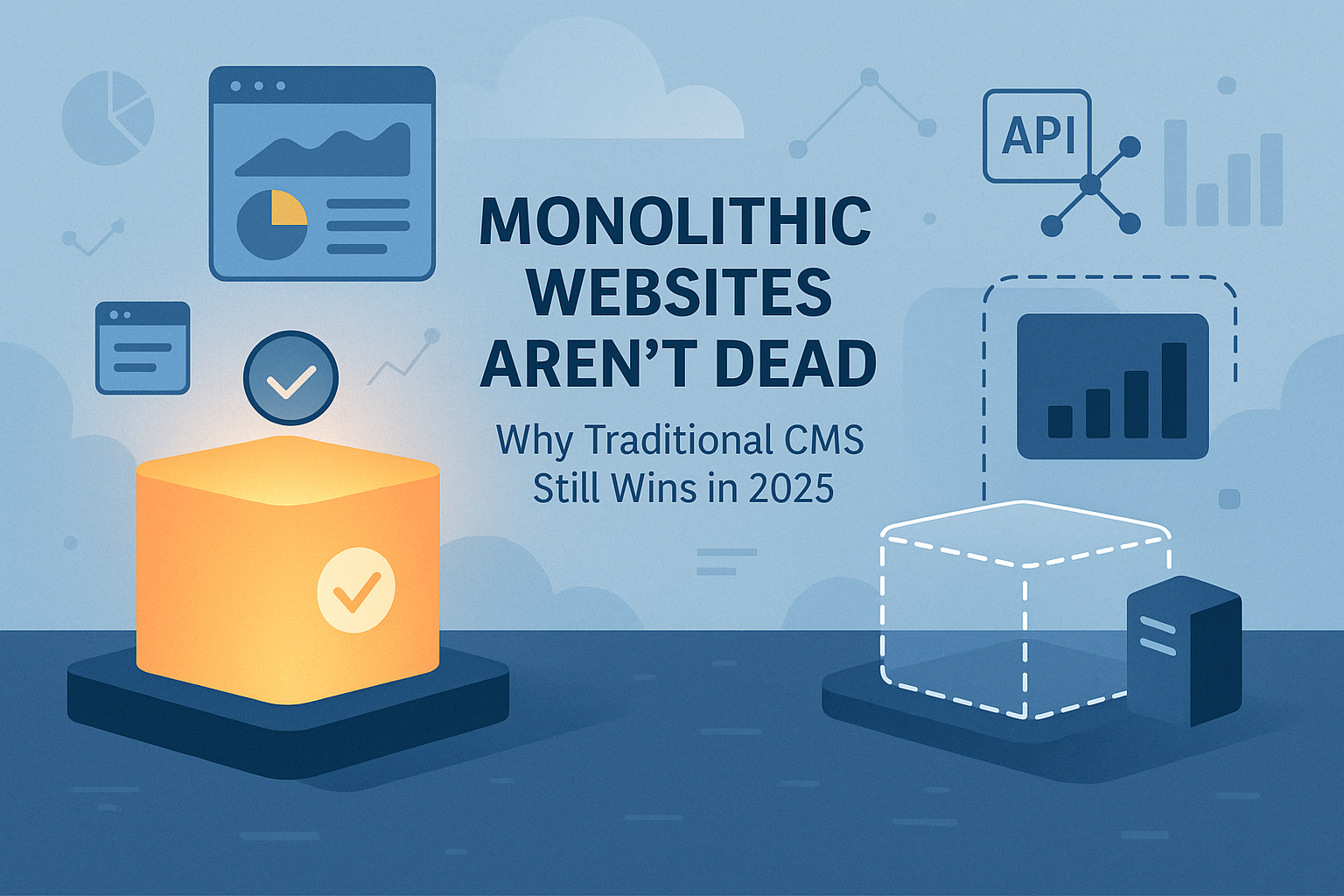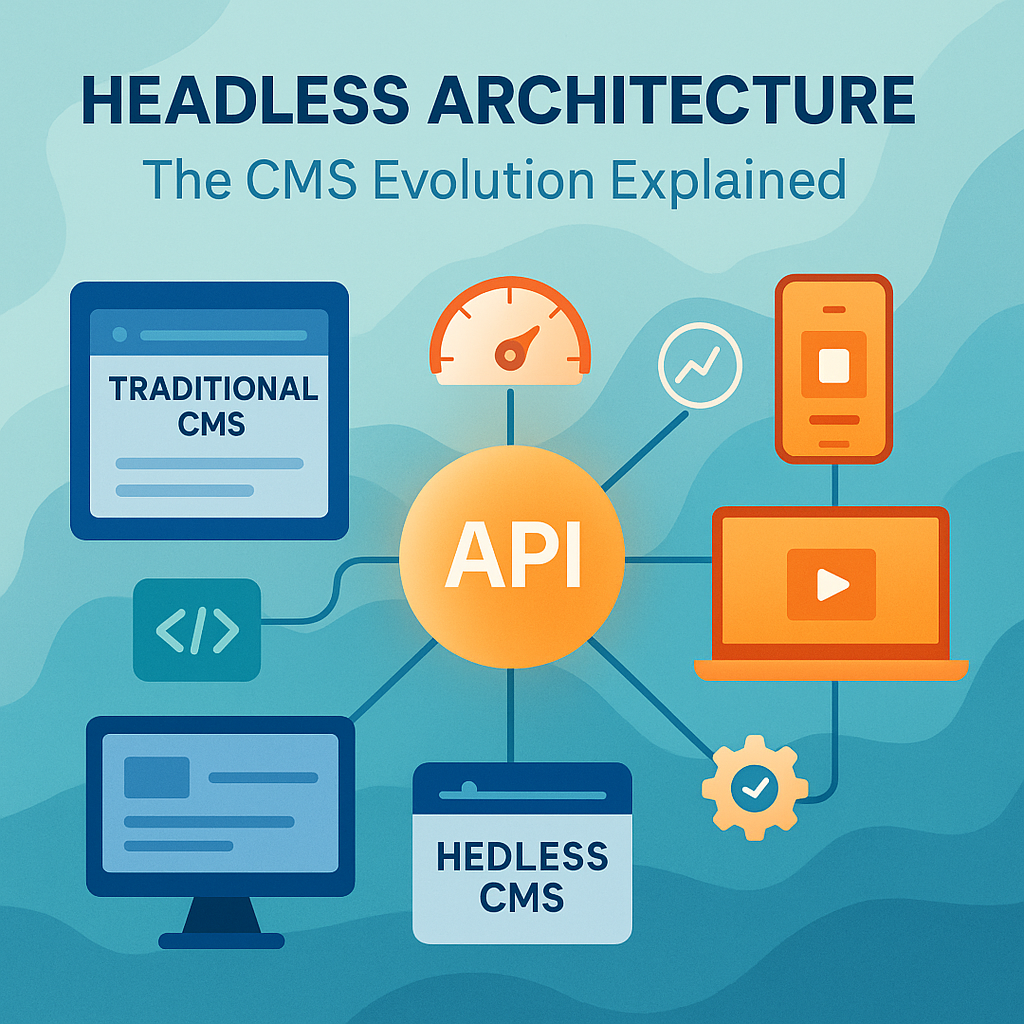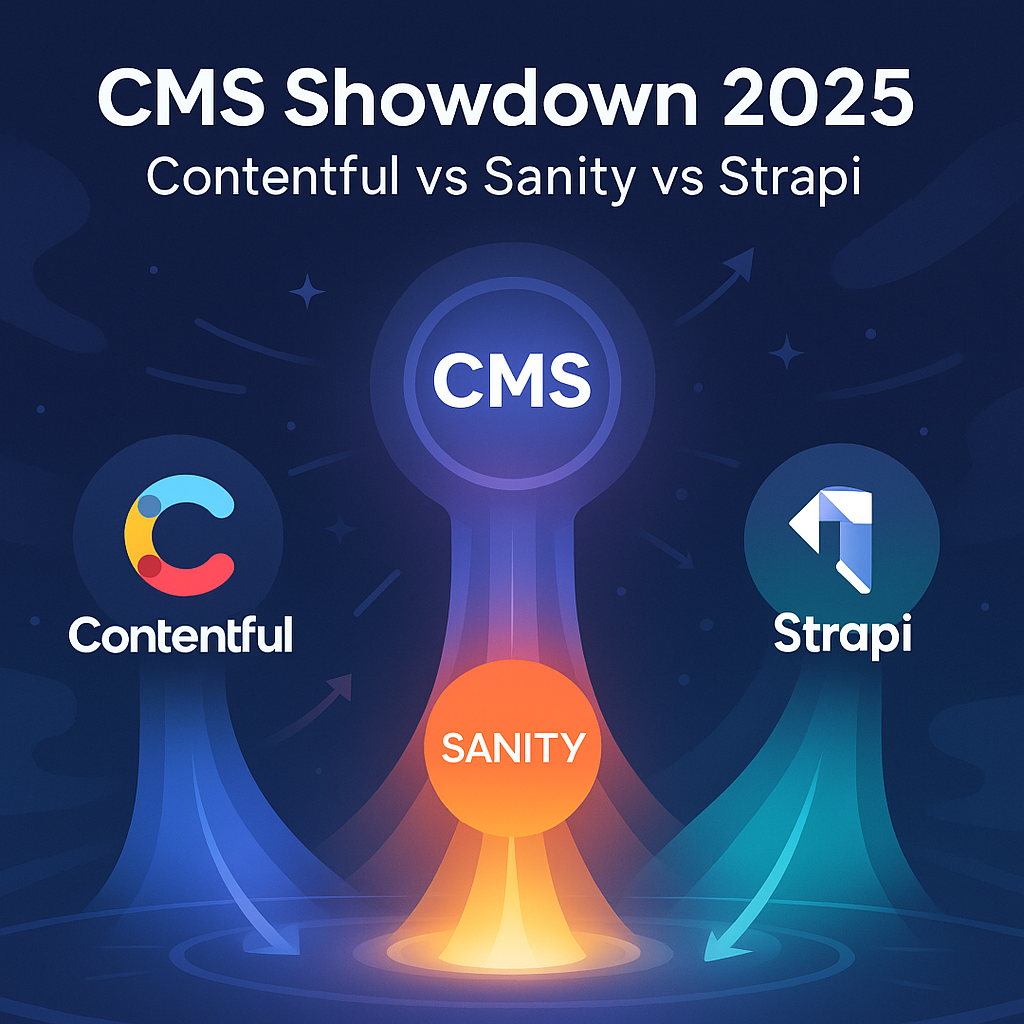Five years ago, the only CMS most businesses knew was WordPress. Maybe Drupal if they were feeling adventurous. In 2025, the web looks completely different, and "headless" is the new buzzword everyone's throwing around. But what does it actually mean? And more importantly, does your business really need it?
Here's the thing. We've watched too many companies jump on the headless bandwagon because it sounds cutting-edge, only to realize they've overcomplicated their entire content workflow. On the flip side, we've seen businesses stick with traditional systems when a headless approach could have saved them thousands of hours and dollars.
The truth is, there's no universal winner in the monolithic vs headless CMS debate. There's only what works for your specific situation. In this article, we'll compare these two architectures across five critical factors (structure, flexibility, speed, scalability, and cost) to help you choose the right system for your next website or app. No hype, no bias, just practical insights you can actually use.
CMS Architecture 101: What Monolithic and Headless Really Mean
Let's start with the basics, because honestly, most explanations of CMS architecture read like they were written by robots for robots.
A monolithic CMS is what you probably think of when someone says "content management system." WordPress, Drupal, Joomla, these are all monolithic. Everything comes bundled together in one neat package: your content management, your database, your templates, your frontend presentation layer. It's all there, ready to go.
Think of it like a restaurant with the kitchen and dining room in the same building. The chef cooks the food, plates it, and serves it right there. Simple, efficient, everything under one roof. As we explored in our Marketer's Playbook guide to choosing the right CMS, simplicity often beats complexity for most business needs.
A headless CMS, on the other hand, separates the content management backend from the frontend presentation. Your content lives in one place and gets delivered through APIs to anywhere you need it: websites, mobile apps, smart watches, digital billboards, you name it.
Using our restaurant analogy, a headless CMS is like a cloud kitchen. The kitchen prepares the food, but it doesn't care where it gets eaten. DoorDash picks it up? Great. Customer walks in? Sure. Catering for an event? No problem. The kitchen just makes the content; how and where it gets consumed is someone else's job.
Here's a quick comparison to make this crystal clear:
Feature | Monolithic CMS | Headless CMS |
Architecture | Tightly integrated | Decoupled (API-based) |
Frontend | Built-in (themes/templates) | Separate (React, Next.js, etc.) |
Hosting | Single environment | Distributed or cloud-based |
Use Case | Websites | Websites, apps, digital experiences |
Now, you might be thinking, "Okay, but why would I want to separate everything? Isn't that just making things more complicated?"
Great question. Let's talk about why developers and large teams are going crazy for headless architecture.
The Headless Advantage: Speed, Scalability, and Freedom
The headless CMS movement isn't just about being trendy (though there's definitely some of that going on). There are legitimate technical advantages that make headless architecture compelling for certain use cases.
First up: speed. Because headless CMSs deliver content through APIs, you can cache that content on CDNs around the world. Your users in Tokyo get content from a server in Tokyo, not from your origin server in Virginia. Pages load in milliseconds, not seconds. And Google loves fast sites, so your SEO performance gets a boost too.
Then there's scalability. Remember how we mentioned delivering content to multiple platforms? That's where headless really shines. Nike's global web team adopted a headless architecture to unify content across more than 190 localized sites while maintaining sub-second load times. One content repository, hundreds of different presentations. Try doing that with WordPress. Our expert Q&A with enterprise developers reveals this multi-channel capability is becoming essential for global brands.
But the real game-changer is freedom. With a headless CMS, your developers can use whatever frontend framework they want. React? Next.js? Vue? Svelte? Go for it. Your web design team isn't locked into WordPress themes or Drupal templates. They can build exactly what you envision without fighting against the CMS.
According to recent data, headless CMS adoption has grown 35% year-over-year. Contentful, Sanity, Strapi, these platforms are exploding because they give developers what they've been asking for: complete control over the frontend experience.
But (and this is a big but), headless isn't all sunshine and rainbows.
You need developer support. Not just occasionally, but ongoing. Setting up a headless CMS isn't something your marketing intern figures out over a weekend. It requires real technical expertise.
The upfront cost is higher too. You're not just paying for a CMS; you're paying for API calls, CDN usage, potentially multiple hosting environments. And someone needs to build that custom frontend. Those React developers? They're not cheap.
We worked with a startup last year that went headless because they thought it would future-proof their platform. Six months later, they switched back to WordPress. Why? They didn't have the technical resources to maintain it. Every content update required developer involvement. Their marketing team couldn't just log in and publish a blog post anymore.
Why Monolithic CMSs Still Win for Small Business Simplicity
Let us defend the "old" way for a minute, because monolithic CMSs like WordPress aren't going anywhere. In fact, they're perfect for most small to mid-sized businesses.
Everything's integrated. You install WordPress, pick a theme, add some plugins, and boom, you've got a website. Your content marketing team can log in, write a post, add images, and publish without calling IT. The preview looks exactly like the published page because they're using the same system.
Maintenance is straightforward too. Update WordPress, update your plugins, maybe clear the cache. You don't need a DevOps engineer or a complex deployment pipeline. Most good hosting providers handle the technical stuff automatically. As we covered in our WordPress optimization guide, proper setup can deliver enterprise-level performance without the complexity.
Here's a real example. A law firm in Michigan was considering moving from WordPress to a headless setup because they'd heard it was "the future." We ran the numbers:
Headless setup: $45,000 initial development, $3,000/month maintenance
WordPress optimization: $8,000 for migration to managed hosting with proper caching
Result: 60% cost savings, 2x faster page loads, happy marketing team
They stayed with WordPress, invested in better hosting and caching tools, and their site flies. Sometimes the boring choice is the smart choice.
Let's look at the cost breakdown:
Cost Factor | Monolithic CMS | Headless CMS |
Initial Setup | Low ($5-15K) | High ($30-100K+) |
Maintenance | Simple (~$500/month) | Requires DevOps ($2-5K/month) |
Hosting | Included or low-cost | Custom/cloud-based |
Ideal For | SMBs, marketing sites | Enterprises, apps, multi-channel |
The numbers don't lie. Unless you genuinely need the flexibility of headless, a monolithic CMS probably makes more financial sense.
Choosing for the Future: Where Each CMS Model Excels
So how do you actually decide? Let's break it down by what matters most to your business.
SEO Considerations
Both architectures can rank well, but they require different approaches. Monolithic CMSs like WordPress come with SEO tools built in. Yoast, Rank Math, these plugins handle your meta tags, sitemaps, schema markup, everything you need. It just works.
With headless, you need to build all that SEO functionality yourself. Meta tags? Custom code. XML sitemaps? Custom implementation. Structured data? Hope your developer knows what they're doing. It's totally doable, but it's not automatic.
That said, the speed advantages of headless can give you an SEO edge. Google's Core Web Vitals love fast-loading pages, and headless architectures typically crush those metrics.
Content Workflow
This is where things get interesting. If you're a global team publishing content across multiple channels, headless wins hands down. Content creators write once, and that content flows to your website, mobile app, email newsletters, wherever. The modular approach means different teams can work on different channels without stepping on each other's toes.
But for straightforward web publishing? Monolithic keeps things simple. Your team logs into WordPress, writes content, formats it, previews it, and publishes. No API calls, no separate preview environments, no confusion about where content lives.
Long-term Scalability
Thinking five years ahead? Headless gives you more options. As new platforms emerge (AR glasses, anyone?), you can deliver content there without rebuilding your entire CMS. Your content becomes truly platform-agnostic.
But here's what's interesting: WordPress isn't standing still. With the WordPress REST API and GraphQL support, it's becoming more headless-friendly. You can use WordPress as a headless CMS if you want, getting the best of both worlds. Hybrid approaches are becoming more common, and they might be the real winner here.
As the team at Sanity puts it: "Headless isn't just about decoupling; it's about delivering content where your users are, faster." That's the core value proposition. If your users are everywhere, headless makes sense. If they're primarily on your website, monolithic works fine.
Making the Decision: A Practical Framework
Let us give you a simple framework for making this choice.
Choose headless if:
You need to deliver content to multiple platforms (web, mobile, IoT)
You have dedicated developer resources
Performance is absolutely critical
You're building a content platform, not just a website
Your content needs to scale globally
Stick with monolithic if:
Your primary channel is a website
Your marketing team needs autonomy
Budget is a major constraint
You want proven, stable solutions
Speed to market matters more than technical flexibility
You know what? There's also a middle path. Platforms like WordPress can work in "headless mode" using their REST API. Newer CMSs like Payload and Directus offer the simplicity of traditional systems with the flexibility of headless architecture. The lines are blurring, and that's good news for everyone.
The Real Winner? It Depends
We've built sites on WordPress that handle millions of visitors. We've also architected headless systems that power global digital experiences. Neither approach is inherently better. They're tools, and like any tool, effectiveness depends on how you use them.
The best CMS isn't the newest or the most technically impressive. It's the one that fits your team, your goals, and your growth plan. Don't let anyone convince you otherwise.
For most businesses, especially those focused on content marketing and web presence, a modern monolithic CMS provides everything you need. WordPress powers 43% of the internet for a reason. It works, it's supported, and your team can actually use it.
But if you're building the next digital platform, delivering content across dozen of touchpoints, or need ultimate performance and flexibility? Headless architecture gives you the control and scalability to compete at the highest level.
The architecture debate isn't about picking winners and losers. It's about understanding your options and making informed decisions. Now you have the knowledge to do exactly that.
Ready to modernize your CMS but not sure which direction to go? Let's talk about your specific needs and find the perfect solution for your business.
External Resources:


